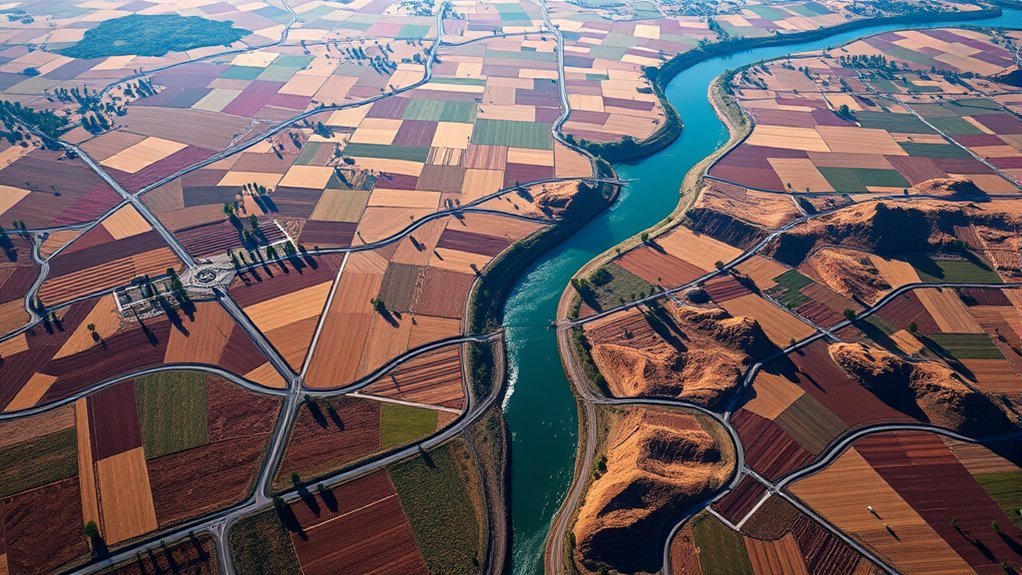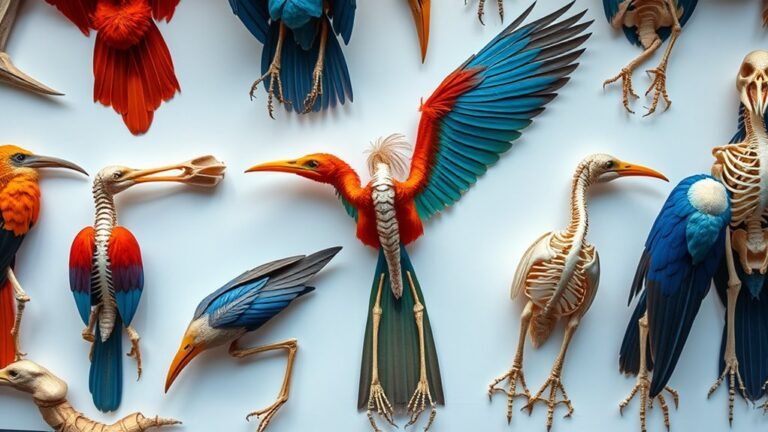Understanding the Concept of Bird’s Eye View
A bird's eye view offers a unique way to look at our surroundings. This perspective allows you to see layouts and patterns that you often miss at ground level. It emphasizes spatial relationships. By examining its history and modern uses, you can see how this viewpoint impacts areas like urban planning and visual arts. The insights you gain can be enlightening and intriguing.
Key Takeaways
- A bird's eye view offers an elevated perspective, revealing patterns and spatial relationships not visible from ground level.
- Historically, this concept has roots in ancient art and architecture, aiding storytelling and community understanding.
- In visual arts, it enhances expression and audience engagement by adjusting scale and emphasis.
- The bird's eye view supports decision-making in business by providing a comprehensive analysis of data and fostering collaboration.
- Implementing this perspective within organizations promotes adaptability, innovation, and effective problem-solving strategies.
What Is a Bird's Eye View?

A bird's eye view gives you an overall picture from above. This perspective helps you see the layout and details of various areas, whether they're urban or natural.
From this view, you can spot patterns and connections that mightn't be clear from ground level. It helps you feel more connected to your environment and appreciate how different elements interact.
Historical Origins of the Concept
The concept of a bird's eye view isn't a new idea. It has roots in ancient civilizations. Many cultures used this perspective in architecture and art. They created elevated views that showed grandeur and connections between elements.
For example, ancient Egyptian hieroglyphs often showed scenes from above. This style was significant for storytelling.
As you look into these practices, you'll see how societies used this viewpoint to share important stories and build a sense of community. Each historical example shows not just the beauty of this perspective but also how it helped people understand their surroundings.
Recognizing these origins can deepen your appreciation for the bird's eye view and highlight its ongoing importance in our lives today.
Bird's Eye View in Cartography

Bird's eye views are important in cartography. This perspective helps you see geographic areas from above, providing a clear understanding of spatial relationships.
Cartographic projections use this method to show the Earth's surface on flat maps, making them easy to read and use. Aerial imagery from drones or satellites captures detailed bird's eye views that benefit urban planning, environmental monitoring, and navigation.
Using these views in cartography aids analysis and decision-making, helping you connect with the environments you study. Understanding bird's eye views boosts your confidence in exploring geographic spaces.
Applications in Architecture
Bird's eye views are important in architecture. They give architects and builders a high perspective. This view helps with understanding space and improving design. With this viewpoint, you can see how buildings relate to each other. It helps you apply design principles that create balance and harmony.
In urban planning, bird's eye views help integrate landscapes. They ensure designs work well while looking good. By focusing on aesthetics, you can design buildings that appeal to the community.
Bird's eye views can improve how space is used, making structures more efficient. They also help assess the environmental effects of projects. Using this perspective enriches architectural work and connects it to the environment.
The Role in Visual Arts

Bird's eye views hold significant value in visual arts. They provide unique perspectives that enhance artistic expression. By using this viewpoint, artists can transform their compositions, allowing viewers to connect with the artwork in fresh ways.
This elevated angle can reveal patterns and relationships that may be missed from the ground, encouraging deeper understanding of the art. For example, landscapes shown from above can create feelings of vastness and connection to nature.
Artists can also adjust the scale and form in their work, making some elements stand out while reducing the emphasis on others. By adopting a bird's eye view, artists invite meaningful conversations with their audience, fostering a sense of belonging and shared experience.
Storytelling Through a Bird's Eye Lens
When you view storytelling from a bird's eye perspective, new layers of narrative emerge.
This viewpoint allows you to see events and emotions in a broader context. You can observe the connections between characters and their surroundings, creating depth in visual storytelling.
By stepping back, you can identify patterns and themes that may not be clear from a close-up view. This wider perspective fosters a sense of connection, showing the shared experiences and feelings of characters.
Using this approach in storytelling enhances the narrative and engages the audience, offering deep insights into human interactions and our stories.
Enhancing Decision-Making Processes
Looking at decision-making from a broader view provides insights into choices and their effects. This perspective helps you spot patterns and possible results that may not be obvious.
You can use data to turn information into clear strategies. Additionally, working together in decision-making builds teamwork and connection. When everyone contributes, different ideas merge, leading to better choices.
Benefits of a Broader Perspective
A broader perspective helps you see connections and trends that are often missed. This way of thinking improves your understanding and leads to better choices.
Here are some benefits you'll notice:
- Better Problem-Solving: You'll tackle challenges with a clearer strategy, finding creative solutions that consider every angle.
- Improved Relationships: Seeing the big picture fosters empathy, helping you connect with others and make them feel valued.
- Smarter Decisions: With a complete view, your choices reflect a variety of influences, aligning with both personal and group goals.
Adopting this broader perspective strengthens your ability and enhances your sense of belonging in your community.
Bird's Eye View in Business Strategy
In business strategy, using a bird's eye view is key for success. By looking at your organization from a broader angle, you can align various departments more effectively.
This clear approach helps you see how every part connects, ensuring everyone works toward shared goals. A solid competitive analysis lets you spot market trends and threats.
Understanding the landscape enables you to make informed decisions and avoid quick reactions. Ultimately, this higher perspective encourages teamwork and unity, helping your business adapt and succeed in a changing environment while keeping your objectives in focus.
Geographic Information Systems (GIS) and Bird's Eye View
Geographic Information Systems (GIS) help you see and understand spatial data clearly. With GIS, you can analyze data and visualize it effectively. This technology connects people and fosters a sense of community.
Here are three ways GIS supports belonging:
- Better Decision-Making: Use visual data to make informed decisions that aid your community.
- Team Projects: Collaborate with others on projects needing spatial insights, promoting teamwork.
- Community Engagement: Learn how different factors connect, which encourages pride and responsibility for your area.
Using GIS empowers you to enhance your understanding of the environment and contribute positively to your community.
Challenges of Maintaining Perspective
Maintaining perspective is challenging when faced with a lot of data and different viewpoints, especially when using GIS tools. It's easy to get lost in small details and miss overall trends.
To manage this, create clear frameworks that help you focus on what matters. Filter the data to highlight relevant insights.
Talking with peers can offer new viewpoints that enrich your understanding and create a sense of community. While challenges may come up, striving for a balanced perspective helps you combine different information into clear insights that support effective decision-making.
Techniques for Achieving a Bird's Eye View
To achieve a bird's eye view, using effective techniques can improve your ability to gather insights and recognize trends.
Here are three methods to consider:
- Change Your Perspective: Regularly alter your viewpoint. This helps you challenge your assumptions and discover new insights.
- Visualize Data: Create clear charts and graphs. This makes it easier to see patterns and connections within large amounts of information.
- Collaborate: Work with diverse groups. Different perspectives can deepen your understanding and enrich your insights.
These strategies can enhance your ability to synthesize information and spot key trends effectively.
Case Studies: Successful Use of Bird's Eye View
Many organizations overlook the potential of a bird's eye view. However, several case studies show how it can improve decision-making and strategies.
For example, a large retailer struggled with stagnant sales until they analyzed customer data from a broader perspective. This revealed hidden trends and preferences. As a result, they adjusted their marketing strategies and saw significant sales growth.
In another case, a tech company used a bird's eye view for project management. This approach helped them simplify processes and improve team collaboration.
These examples demonstrate that taking a comprehensive view can lead to innovation and success. By using these insights, you can foster a culture that adapts quickly and effectively within your organization.
Frequently Asked Questions
How Does Bird's Eye View Differ From Ground-Level Perspectives?
A bird's eye view provides a clear understanding of spatial relationships by showing wider patterns. It allows for easy comparisons and helps you see connections in a larger area. In contrast, ground-level perspectives focus on details but can miss broader context. This difference can shape your analysis and understanding of a given environment.
Can Bird's Eye View Be Used in Virtual Reality Applications?
Yes, bird's eye view can be used in virtual reality applications. This perspective improves user experience and spatial awareness. It helps users move around environments easily. This makes exploring digital spaces more enjoyable and engaging.
What Tools Are Needed to Create a Bird's Eye View Image?
To create a bird's eye view image, use a drone for photography to capture aerial shots. Pair this with mapping software to layer and visualize your images accurately. This combination gives a clear overview of landscapes, improving the depth and perspective of your project.
Are There Alternative Terms for Bird's Eye View in Different Fields?
In various fields, "bird's eye view" may be called "aerial perspective" in art or "overview" in project management. These terms highlight a wide perspective, helping you see the overall situation clearly. Understanding these alternatives can improve communication and clarity within different disciplines.
How Does Cultural Context Affect the Interpretation of Bird's Eye View?
Cultural context affects how you interpret bird's eye view. Your background shapes your understanding of distances and relationships in images. Different symbols and cultural meanings can change how you see a broader perspective. This influences your appreciation and understanding of what you observe from above.

Hello, I’m Emily Price, the founder of Birds Affection. As a passionate bird enthusiast and spiritual seeker, I’ve always been fascinated by the symbolic meanings and mystical connections between birds and our lives. On this website, I share my knowledge and insights on the spiritual significance of various bird species, exploring their roles as messengers, guides, and teachers. Through my writing, I aim to inspire and educate others on the profound wisdom and beauty that birds bring to our world. Join me on this journey as we delve into the enchanting realm of bird symbolism and discover the hidden meanings behind these magnificent creatures.







